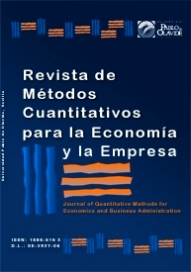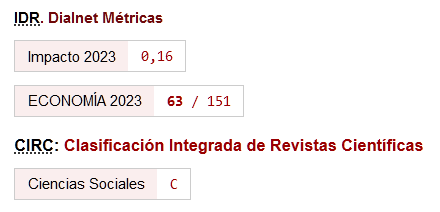Detección de factores relevantes en redes sociales incorporando información de expertos
DOI:
https://doi.org/10.46661/rev.metodoscuant.econ.empresa.8135Palabras clave:
Inferencia bayesiana, simulación MCMC, distribución a priori informativa, redes socialesResumen
La mayoría de las empresas utilizan las redes sociales como canales de comunicación debido a los beneficios empresariales que pueden proporcionar. Este artículo se centra en el impacto de las redes sociales en una fundación española dedicada a la innovación y la difusión del conocimiento, y en cómo afectan a sus principales eventos y actividades. Examinamos los factores subyacentes a un retuit en Twitter o una compartición en Facebook con el fin de analizar la difusión de los eventos principales de esta fundación. Se realizaron comparaciones con tres modelos estadísticos (regresión estándar y regresión bayesiana con distribución a priori informativa y no informativa). Concluimos que la ventaja que ofrece la metodología bayesiana sobre la clásica se demuestra mediante la incorporación de información colateral, generalmente proporcionada por expertos, lo que permite refinar el modelo y obtener conclusiones que, de otro modo, no podrían ser identificadas. Esta conclusión puede tener implicaciones significativas para las empresas que utilizan redes sociales.
Descargas
Citas
Akaike, H. (1974). A new look at the statistical model identification. IEEE Transactions on Automatic Control, 19(6), 716-723.
https://doi.org/10.1109/TAC.1974.1100705
Butts, C. (2003). Network inference, error, and informant (in)accuracy: a Bayesian approach. Social Networks, 25(2), 103-140.
https://doi.org/10.1016/S0378-8733(02)00038-2
Caimo, C. and Friel, N. (2011). Bayesian inference for exponential random graph models. Social Networks, 33(1), 41-55.
https://doi.org/10.1016/j.socnet.2010.09.004
Caimo, C. and Friel, N. (2013). Bayesian model selection for exponential random graph models. Social Networks, 35(1), 11-24.
https://doi.org/10.1016/j.socnet.2012.10.003
Carlin, B.P. and Polson, N.G. (1992). Monte Carlo Bayesian methods for discrete regression models and categorical time series. In: Bernardo, J.M., Berger, J.O., Dawid, A.P. and Smith, A.F.M. eds. Bayesian Statistics, 4, 577-86. University Press, Oxford.
https://doi.org/10.1093/oso/9780198522669.003.0032
Carrington, P.J., Scott, J. andWasserman, S. (Eds.) (2005). Models and Methods in Social Networks Analysis. Cambridge University Press, Cambridge.
https://doi.org/10.1017/CBO9780511811395
Eriksson, M. and Olsson Gardell, E. (2016). Facebook and Twitter in Crisis Communication: A Comparative Study of Crisis Communication Professionals and Citizens. Journal of Contingencies and crisis Management, 24(4), 198-208.
https://doi.org/10.1111/1468-5973.12116
García-de-Torres, E., Yezerska, L., Rost, A., Calderón, M., Edo, C., Rojano, M., Said-Hung, E., Jerónimo, P., Arcila, C., Serrano-Tellería, A., Sánchez-Badillo, J. and Corredoira, J. (2011). Uso de Twitter y Facebook por los medios iberoamericanos. El profesional de la información, 20(6), 611-620.
https://doi.org/10.3145/epi.2011.nov.02
Gilks, W.R., Richardson, S. and Spiegelhalter, D.J. (1995). Introducing markov chain montecarlo. In: Gilks, W.R., Richardson, S., Spiegelhalter, D.J., eds. Markov Chain Monte Carlo in Practice. Chapman and Hall, London.
https://doi.org/10.1201/b14835
Golbeck, J. and Hansen, D. (2014). A method for computing political preference among Twitter followers. Social Networks, 36, 177-184.
https://doi.org/10.1016/j.socnet.2013.07.004
Guzmán, A.P., Moral, E. and González, F. (2012). Twitter use in the Latin American Universities. RELATEC, Revista Latinoamericana de Tecnología Educativa, 11(1), 27-39.
Harrigan, N., Achananuparp, P. and Lim, E. (2012). Influentials, novelty, and social contagion. The viral power of average friends, close communities, and old news. Social Networks, 34, 470-480.
https://doi.org/10.1016/j.socnet.2012.02.005
Hsu, H.W., Lancaster, J., Paradesi, M. and Weninger, T. (2007). Structural Link Analysis from User Profiles and Friends Networks: A Feature Construction Approach. En Proceedings of ICWSM-2007.
Huber, P.J. (1967). The behavior of maximum likelihood estimate under nonstandard conditions. En Proceedings of the Fifth Berkeley Symposium on Mathematical Statistics and Probability, 1, 221-233. Ed. Berkeley, University of California Press.
Kaplan, D. (2014). Methodology in the social sciences. Bayesian statistics for the social sciences. Guilford Press, New York.
Koop, G. (2003). Bayesian Econometrics. John Wiley & Sons Inc., United Kingdom.
Koskinen, J.H. and Snijders, T.A.B. (2007). Bayesian inference for dynamic social network data. Journal of Statistical Planning and Inference, 137, 3930-3938.
https://doi.org/10.1016/j.jspi.2007.04.011
Koskinen, J.H., Robins, G.L., Wang, P. and Pattison, P.E. (2013). Bayesian analysis for partially observed network data, missing ties, attributes and actors. Social Networks, 35(4), 514-527.
https://doi.org/10.1016/j.socnet.2013.07.003
Lunn, D.J., Thomas, A., Best, N. and Spiegelhalter, D. (2000). WinBUGS: a Bayesian modelling framework: concepts, structure and extensibility. Statistics and Computing, 10, 325-337.
https://doi.org/10.1023/A:1008929526011
Oliveira, S.C., Cobre, J. and Ferreira, T.P. (2017). A Bayesian approach for the reliability of scientific co-authorship networks with emphasis on nodes. Social Networks, 48, 110-115.
https://doi.org/10.1016/j.socnet.2016.06.005
Parra, P., Gordo, AJ. and D'Antonio, SA. (2014). Social research applied to social networks. A methodological innovation for the analysis of Facebook Likes. Revista Latina de Comunicación Social, 69, 195-212.
Slaughter, A.J. and Koehly, L.M. (2016). Multilevel models for social networks: Hierarchical Bayesian approaches to exponential random graph modeling. Social Networks, 44, 334-345.
https://doi.org/10.1016/j.socnet.2015.11.002
Spiegelhalter, D.J., Best, N.G., Carlin, B.P. and van der Linde, A. (2002). Bayesian measures of model complexity and fit (with discussion). Journal of the Royal Statistical Society, Series B, 64(4), 583-639.
https://doi.org/10.1111/1467-9868.00353
Statista (2022). Avaliable online: https://es.statista.com/estadisticas/698728/porcentaje-deempresas-
que-hicieron-uso-de-las-redes-sociales-en-espana/.
Túñez, M. and Sixto, J. (2011). Social networks, political and Commitment 2.0: Spanish deputies in Facebook. Revista Latina de Comunicación Social, 66, 1-25.
Túnez, M. and Sixto, J. (2012). The social networks like learning environment: analysis of facebook use in the university teaching. Revista de Medios y Educación, 41, 77-92.
Wasserman, S. and Faust, K. (1994). Social Network Analysis: Methods and Applications. Cambridge University Press, Cambridge.
https://doi.org/10.1017/CBO9780511815478
White, H.L., Jr. (1980). A heteroskedasticity-consistent covariance matrix estimator and a direct test for heteroskedasticity. Econometrica, 48, 817- 838.
https://doi.org/10.2307/1912934
White, H.L., Jr. (1982). Maximum likelihood estimation of misspecified models. Econometrica, 50, 1-25.
https://doi.org/10.2307/1912526
Zellner, A. (1996). An Introduction to Bayesian Inference in Econometrics. John Wiley & Sons Inc., United Kingdom.
Descargas
Publicado
Cómo citar
Número
Sección
Licencia
Derechos de autor 2024 José María Pérez Sánchez, María Acosta García, Emilio Gómez-Déniz

Esta obra está bajo una licencia internacional Creative Commons Atribución-CompartirIgual 4.0.
El envío de un manuscrito a la Revista supone que el trabajo no ha sido publicado anteriormente (excepto en la forma de un abstract o como parte de una tesis), que no está bajo consideración para su publicación en ninguna otra revista o editorial y que, en caso de aceptación, los autores están conforme con la transferencia automática del copyright a la Revista para su publicación y difusión. Los autores retendrán los derechos de autor para usar y compartir su artículo con un uso personal, institucional o con fines docentes; igualmente retiene los derechos de patente, de marca registrada (en caso de que sean aplicables) o derechos morales de autor (incluyendo los datos de investigación).
Los artículos publicados en la Revista están sujetos a la licencia Creative Commons CC-BY-SA de tipo Reconocimiento-CompartirIgual. Se permite el uso comercial de la obra, reconociendo su autoría, y de las posibles obras derivadas, la distribución de las cuales se debe hacer con una licencia igual a la que regula la obra original.
Hasta el volumen 21 se ha estado empleando la versión de licencia CC-BY-SA 3.0 ES y se ha comenzado a usar la versión CC-BY-SA 4.0 desde el volumen 22.










